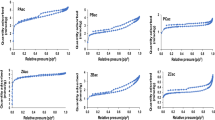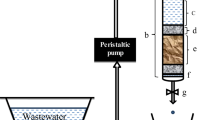Abstract
The removal of perfluorooctanoic acid (PFOA) and perfluorooctane sulfonate (PFOS) from aqueous solutions using agro-waste biomass of Vitis vinifera (grape) leaf litter was studied. Activated carbons were produced from the biomass and chemical activation achieved by using phosphoric acid (H3PO4) and potassium hydroxide (KOH) for the modification of the carbons’ surface morphology. Activated carbons were characterized using Fourier transform infrared spectroscopy, scanning electron microscopy and Brunauer–Emmett–Teller (BET) in order to understand removal mechanisms of the contaminants by activated carbons. The effect of solution concentration, pH, adsorbent dosage, contact time and temperature was evaluated to optimize the removal efficiency of activated carbons. Adsorption isotherm models were used to analyse the equilibrium data obtained, and kinetic models were applied to study sorption mechanisms. The results fitted well into Freundlich isotherm with both AC-KOH and AC-H3PO4 having high K f values. Maximum adsorption capacities for AC-H3PO4 were 78.90 and 75.13 mg/g for PFOA and PFOS, respectively. Equilibrium was reached before 60 min on both adsorbents, and thermodynamic studies indicated that the process was exothermic and spontaneous. Surface morphology showed the abundance of microspores (>60%) with BET total surface area of 295.488 and 158.67 m2/g for AC-H3PO4 and AC-KOH activated carbons, respectively. Removal efficiencies were 95 and 90% for PFOA using AC-H3PO4 and AC-KOH, respectively; corresponding values for PFOS were 94 and 88%. Adsorbents’ removal capacities depended on the physicochemical characteristics of adsorbents.






Similar content being viewed by others
References
Agarwal S, Tyagi I, Gupta VK, Ghasemi N, Shahivand M, Ghasemi M (2016) Kinetics, equilibrium studies and thermodynamics of methylene blue adsorption on Ephedra strobilacea saw dust and modified using phosphoric acid and zinc chloride. J Mol Liq 218:208–218
Ahmad F, Daud WMAW, Ahmad MA, Radzi R (2013) The effects of acid leaching on porosity and surface functional groups of cocoa (Theobroma cacao)-shell based activated carbon. Chem Eng Res Des 91:1028–1038
Ali I, Asim M, Khan TA (2012) Low cost adsorbents for the removal of organic pollutants from wastewater. J Environ Manag 113:170–183
Bäuerlein PS, Mansell JE, ter Laak TL, de Voogt P (2012) Sorption behavior of charged and neutral polar organic compounds on solid phase extraction materials: which functional group governs sorption? Environ Sci Technol 46:954–961
Bedin KC, Martins AC, Cazetta AL, Pezoti O, Almeida VC (2016) KOH-activated carbon prepared from sucrose spherical carbon: adsorption equilibrium, kinetic and thermodynamic studies for methylene blue removal. Chem Eng J 286:476–484
Benford D et al. (2008) Opinion of the scientific panel on contaminants in the food chain on perfluorooctane sulfonate (PFOS), perfluorooctanoic acid (PFOA) and their salts EFSA Journal:1–131
Castiglioni S et al (2015) Sources and fate of perfluorinated compounds in the aqueous environment and in drinking water of a highly urbanized and industrialized area in Italy. J Hazard Mater 282:51–60
Cui L, Zhou QF, Liao CY, Fu JJ, Jiang GB (2009) Studies on the toxicological effects of PFOA and PFOS on rats using histological observation and chemical analysis. Arch Environ Contam Toxicol 56:338–349
Dada A, Olalekan A, Olatunya A, Dada O (2012) Langmuir, Freundlich, Temkin and Dubinin–Radushkevich isotherms studies of equilibrium sorption of Zn2+ unto phosphoric acid modified rice husk. J Appl Chem 3:38–45
Ericson I, Domingo JL, Nadal M, Bigas E, Llebaria X, van Bavel B, Lindström G (2009) Levels of perfluorinated chemicals in municipal drinking water from Catalonia, Spain: public health implications. Arch Environ Contam Toxicol 57:631–638
Ghasemian E, Palizban Z (2016) Comparisons of azo dye adsorptions onto activated carbon and silicon carbide nanoparticles loaded on activated carbon. Int J Environ Sci Technol 13:501–512
Giesy JP, Kannan K (2002) Peer reviewed: perfluorochemical surfactants in the environment. Environ Sci Technol 36:146A–152A
Hameed B, Tan I, Ahmad A (2008) Adsorption isotherm, kinetic modeling and mechanism of 2,4,6-trichlorophenol on coconut husk-based activated carbon. Chem Eng J 144:235–244
Izquierdo MT, Rubio B, Mayoral C, Andrés JM (2003) Low cost coal-based carbons for combined SO2 and NO removal from exhaust gas. Fuel 82:147–151
Jiang W, Zhang Y, Yang L, Chu X, Zhu L (2015) Perfluoroalkyl acids (PFAAs) with isomer analysis in the commercial PFOS and PFOA products in China. Chemosphere 127:180–187
Johnson RL, Anschutz AJ, Smolen JM, Simcik MF, Penn RL (2007) The adsorption of perfluorooctane sulfonate onto sand, clay, and iron oxide surfaces. J Chem Eng Data 52:1165–1170
Kobya M (2004) Removal of Cr (VI) from aqueous solutions by adsorption onto hazelnut shell activated carbon: kinetic and equilibrium studies. Bioresour Technol 91:317–321
Komkiene J, Baltrenaite E (2016) Biochar as adsorbent for removal of heavy metal ions [Cadmium (II), Copper (II), Lead (II), Zinc (II)] from aqueous phase. Int J Environ Sci Technol 13:471–482
Moreno-Castilla C (2004) Adsorption of organic molecules from aqueous solutions on carbon materials. Carbon 42:83–94
Ochoa-Herrera V, Sierra-Alvarez R (2008) Removal of perfluorinated surfactants by sorption onto granular activated carbon, zeolite and sludge. Chemosphere 72:1588–1593
Paul AG, Jones KC, Sweetman AJ (2008) A first global production, emission, and environmental inventory for perfluorooctane sulfonate. Environ Sci Technol 43:386–392
Rattanaoudom R, Visvanathan C, Boontanon SK (2012) Removal of concentrated PFOS and PFOA in synthetic industrial wastewater by powder activated carbon and hydrotalcite. Journal of Water Sustainability 2:245–258
Senevirathna S, Tanaka S, Fujii S, Kunacheva C, Harada H, Ariyadasa B, Shivakoti B (2010) Adsorption of perfluorooctane sulfonate (n-PFOS) onto non ion-exchange polymers and granular activated carbon: batch and column test. Desalination 260:29–33
Sethia G, Sayari A (2016) Activated carbon with optimum pore size distribution for hydrogen storage. Carbon 99:289–294
So M et al (2007) Perfluorinated compounds in the Pearl river and Yangtze river of China. Chemosphere 68:2085–2095
Socrates G (2004) Infrared and Raman characteristic group frequencies: tables and charts: John Wiley & Sons
Strynar MJ, Lindstrom AB, Nakayama SF, Egeghy PP, Helfant LJ (2012) Pilot scale application of a method for the analysis of perfluorinated compounds in surface soils. Chemosphere 86:252–257
Wang F, Shih K (2011) Adsorption of perfluorooctanesulfonate (PFOS) and perfluorooctanoate (PFOA) on alumina: influence of solution pH and cations. Water Res 45:2925–2930
Xin-hui D, Srinivasakannan C, Qu W-W, Xin W, Jin-hui P, Li-bo Z (2012) Regeneration of microwave assisted spent activated carbon: process optimization, adsorption isotherms and kinetics. Chem Eng Process Process Intensif 53:53–62
Xu C, Chen H, Jiang F (2015) Adsorption of perflourooctane sulfonate (PFOS) and perfluorooctanoate (PFOA) on polyaniline nanotubes. Colloids Surf A Physicochem Eng Asp 479:60–67
Yu Q, Zhang R, Deng S, Huang J, Yu G (2009) Sorption of perfluorooctane sulfonate and perfluorooctanoate on activated carbons and resin: kinetic and isotherm study. Water Res 43:1150–1158
Zhang P, Wang T, Qian G, Wu D, Frost RL (2014) Removal of methyl orange from aqueous solutions through adsorption by calcium aluminate hydrates. J Colloid Interface Sci 426:44–47
Acknowledgement
The authors wish to acknowledge the financial support of the National Research Foundation (NRF), South Africa, for the Thuthuka Research Grant No. 84185 awarded to Prof B.O. Opeolu.
Author information
Authors and Affiliations
Corresponding author
Additional information
Responsible editor: Philippe Garrigues
Electronic supplementary material
ESM 1
(DOCX 113 kb)
Rights and permissions
About this article
Cite this article
Fagbayigbo, B.O., Opeolu, B.O., Fatoki, O.S. et al. Removal of PFOA and PFOS from aqueous solutions using activated carbon produced from Vitis vinifera leaf litter. Environ Sci Pollut Res 24, 13107–13120 (2017). https://doi.org/10.1007/s11356-017-8912-x
Received:
Accepted:
Published:
Issue Date:
DOI: https://doi.org/10.1007/s11356-017-8912-x




